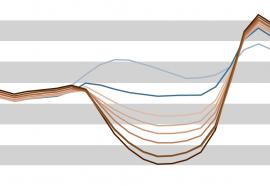Renewables
Duke Energy Progress agreed to purchase $1.2 billion in generating assets from North Carolina Eastern Municipal Power Agency; ABB won a $400 million order that would create the first electricity link between Newfoundland and the North American power grid; Siemens Energy secured an order for a total capacity of 36 MW in Germany; NextEra Energy Partners’ Bluewater Wind Energy Center in Ontario began commercial operation; the Department of Energy took the first step toward issuing a $150 million loan guarantee to support construction of the Cape Wind offshore wind project; and others ...
Digest (August 2014)
Florida Power & Light Company partners with PetroQuest Energy to develop natural gas production wells in southeastern Oklahoma; First Solar receives financing approval to build a 141-MW solar power plant in Chile; DTE Energy will deploy Tollgrade’s LightHouse MV smart grid sensors and predictive grid analytics platform within its distribution network in Detroit; US DOE chooses Abengoa, together with the National Renewable Energy Laboratory and the Colorado School of Mines, to develop a new solar storage technology for thermoelectric plants.
The End of an Age
Survival in the new market requires embracing new technologies and practices.
New technologies are opening the utility domain to innovation and competition. Traditional utilities will shrink as outsourcing providers and competitors grow. Survival in this new market requires embracing new technologies and practices.
Toward a 21st Century Grid
Producing value with advanced distribution management systems.
Changing demands from regulators, customers, and shareholders are driving utilities toward better operational technologies to manage an increasingly complex grid. Advanced distribution management systems (ADMS) promise nearly real-time operational insight for maintaining reliability, safety, and security.
Customer First
Is the current regulatory compact in anyone’s best interests?
Serving customers’ needs should be a top priority for power companies, irrespective of the regulatory construct and business model. Transformation doesn’t change this basic fact, but how do we break the model without breaking the system?
Reinventing the Grid
How to find a future that works.
The traditional central-station grid is evolving toward a more distributed architecture, accommodating a variety of resources spread out across the network. An open and thoughtful planning approach will allow an orderly transition to an integrated system – while fostering innovation among a wider range of industry players.
Putting a Price on Carbon
How EPA can establish a U.S. GHG Program for the Electricity Sector.
With the Environmental Protection Agency’s proposed greenhouse gas (GHG) emissions standards expected in June 2014, many states are considering their own approaches to provide flexibility in meeting compliance requirements. Experience in North America to date provides policy guidance.
Dealing With the Duck
Designing markets to accommodate variable resources.
Growth in variable resources creates an increasing need for demand response and fast-ramping generation. The right market design can bring both.
Energiewende
Nuclear fear and Germany’s headlong plunge into renewable energy.
On a recent trip to Germany to study the country’s energy policy, the phrase “energy transition,” or “energiewende” as the Germans say, was on everyone’s mind.
How Do You Get To Green?
And what’s the goal: a share of load or a cut in carbon?
It’s time to rethink RPS laws. Instead of production quotas for renewable energy, why not reward reductions in carbon emissions and fossil-fuel use?








